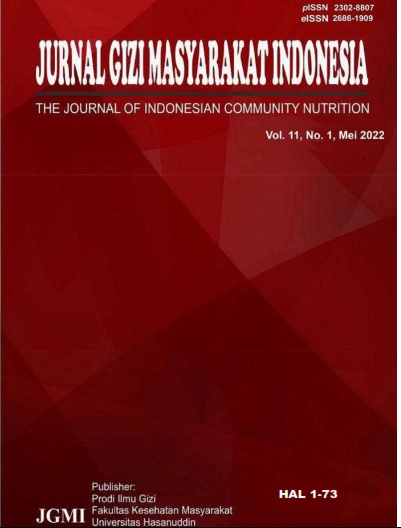THE EFFECT OF EDUCATION THROUGH WHATSAPP ON INTAKES OF ADOLESCENT STUDENTS FACULTY OF AGRICULTURE HASANUDDIN UNIVERSITY
DOI:
https://doi.org/10.30597/jgmi.v11i1.19392Abstract
ABSTRAK Pendahuluan: Anemia merupakan keadaan rendahnya kadar hemoglobin (Hb) yang sering disebabkan oleh asupan mikronutrien yang tidak adekuat. Anemia pada remaja putri biasa disebabkan oleh rendahnya asupan sumber zat besi dan zat lainnya. Edukasi gizi adalah salah satu upaya mendasar untuk memperbaiki perilaku makan remaja. Edukasi melalui sosial media menjadi salah satu pendekatan edukasi masa kini karena banyak digunakan oleh kalangan remaja, salah satunya WhatsApp. Penelitian ini bertujuan untuk melihat pengaruh edukasi anemia melalui media WhatsApp terhadap asupan zat besi, protein, dan vitamin C. Bahan dan Metode: Penelitian ini menggunakan desain pra-eksperimen dengan one group pretest posttest. Pengambilan sampel menggunakan teknik simple random sampling. Jumlah sampel sebanyak 79 remaja mahasiswi Fakultas Pertanian Universitas Hasanuddin angkatan 2020. Proses edukasi dilakukan selama 4 minggu dengan membagikan materi dalam bentuk teks, poster dan video melalui grup WhatsApp. Data asupan zat besi, protein, dan vitamin C diukur menggunakan SQ-FFQ online. Data dianalisis secara bivariat menggunakan uji statistik Mc Nemar. Hasil: Hasil penelitian menunjukkan terdapat perubahan frekuensi asupan zat besi (p=0,008) yang mana terjadi penurunan pada persentase responden frekuensi asupan zat besi sering. Tidak ada perubahan pada frekuensi asupan protein (p=0,109) dan vitamin C (p=1,000) serta jumlah asupan zat besi (p=1,000), protein (p=0,832) dan vitamin C (p=0,424) sebelum dan setelah diberikan edukasi melalui media WhatsApp. Kesimpulan: tidak terdapat pengaruh pada asupan zat besi, protein, dan vitamin C. Kata kunci: Anemia, Edukasi, WhatsApp, Remaja Putri, Asupan ABSTARCT Introduction: Anemia is a condition of low hemoglobin levels which is often caused by inadequate micronutrient intake. Anemia in adolescent girls is usually caused by a low intake of iron and other nutrients. Nutrition education is one of the fundamental efforts to improve the eating behavior of adolescents. Education through social media become one of the newest educational approaches because it is widely used among teenagers, one of which is WhatsApp. This study aims to determine the effect of anemia education through WhatsApp on intakes of iron, protein, and vitamin C in adolescent girls. Methods: A pre-experimental research design with one group pretest-posttest was applied. The Subject was selected by simple random sampling and conducted on 79 adolescent girl students of the Faculty of Agriculture, Hasanuddin University. The education process is four weeks long by distributing texts, posters, and videos through the WhatsApp group. The intake of iron, protein, and vitamin C was measured using an online semi quantitative-food frequency questionnaire (SQ-FFQ). All of the data were analyzed using the Mc Nemar test. Results: This study shows that there was a change in the frequency of iron intake (p=0,008), in which the frequency of iron intake decreased. There was no change in frequency of protein (p=0,109) and vitamin C (p=1,000) intake, as well as the amount of iron (p=1,000), protein (p=0,832), and vitamin C (p=0,424) intake before and after the education through WhatsApp. Conclusion: There was no effect of anemia education through WhatsApp on frequency and amount of iron, protein, and vitamin C intake. Keywords: Anemia, Education,WhatsApp, Adolescent Girl, IntakesDownloads
Download data is not yet available.
Downloads
Published
2022-06-27
How to Cite
Nento, P. R., Indriasari, R., Syam, A., Virani, D., & Riskiytanti, S. (2022). THE EFFECT OF EDUCATION THROUGH WHATSAPP ON INTAKES OF ADOLESCENT STUDENTS FACULTY OF AGRICULTURE HASANUDDIN UNIVERSITY . Jurnal Gizi Masyarakat Indonesia (The Journal of Indonesian Community Nutrition), 11(1). https://doi.org/10.30597/jgmi.v11i1.19392
Issue
Section
Articles
License

This work is licensed under a Creative Commons Attribution-NonCommercial-ShareAlike 4.0 International License.












